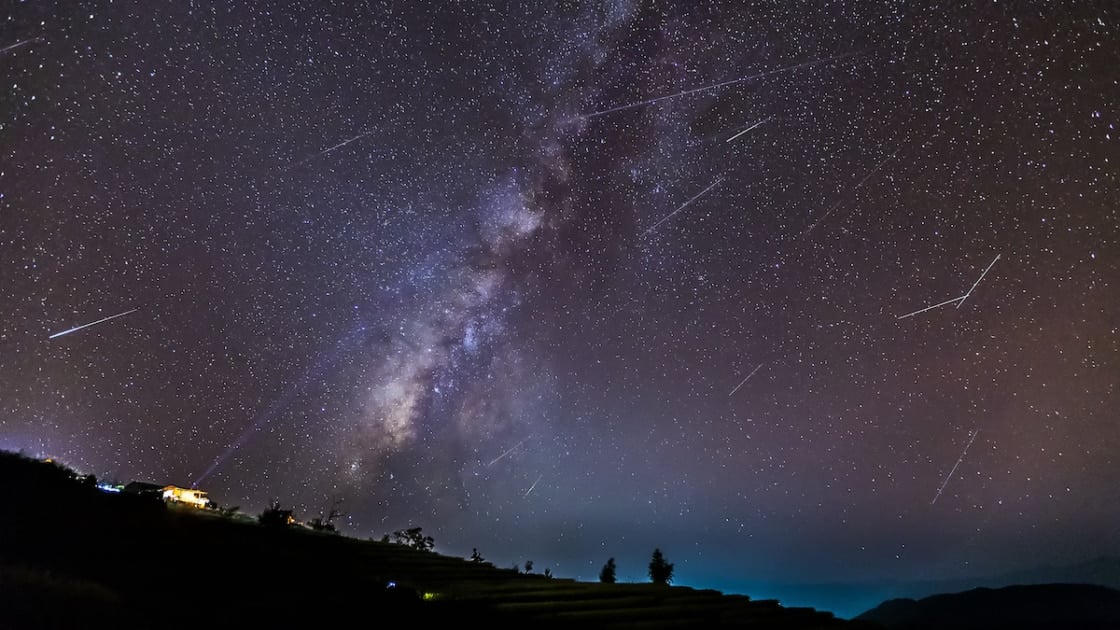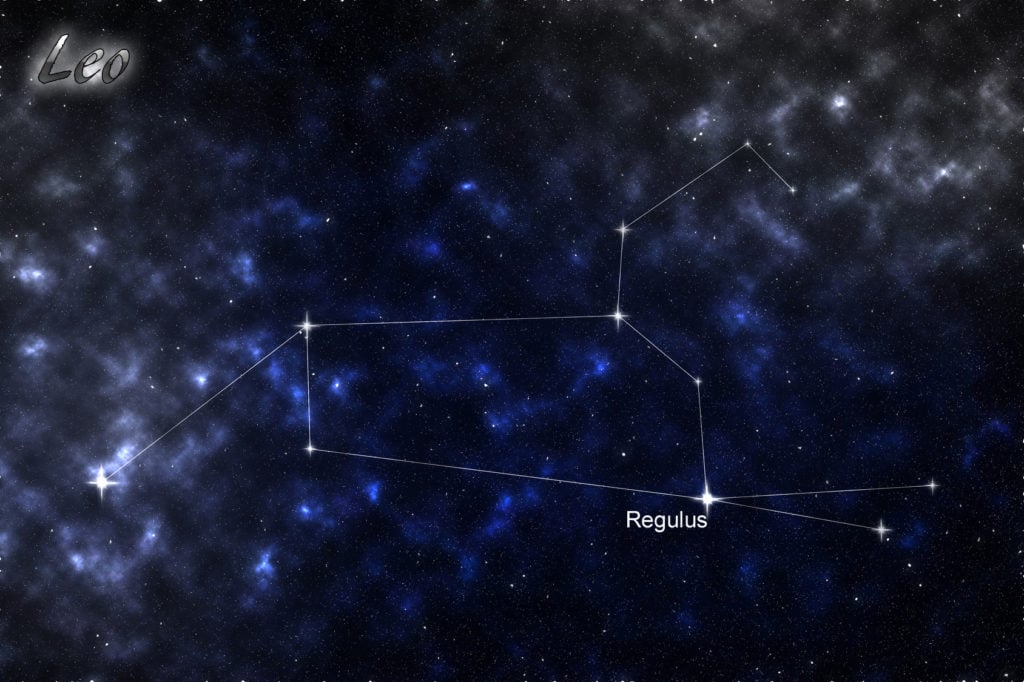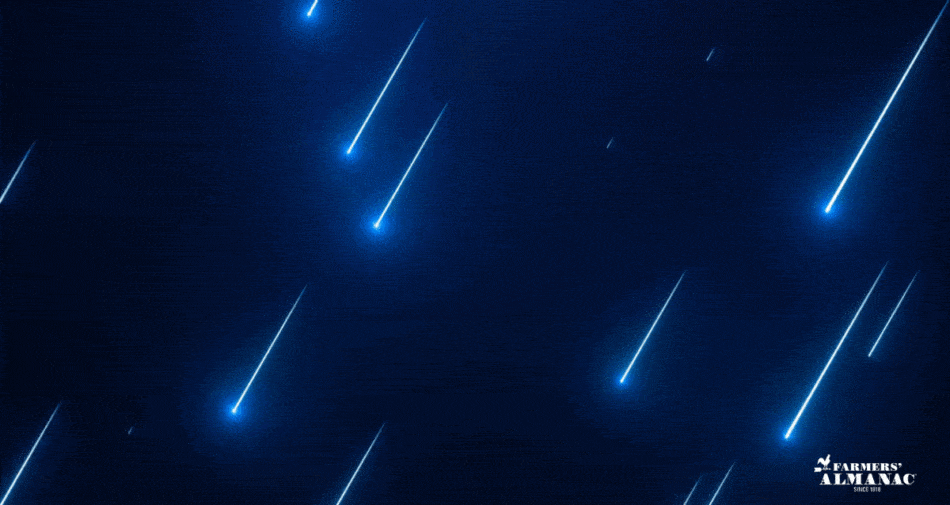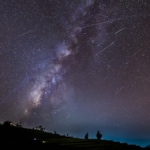The Famous Leonid Meteor Shower 2025

Learn when and where to catch a shooting star in the late-November Leonid Meteor Shower 2025! Here’s everything you need to know …
How To Catch A Shooting Star
The famous Leonid Meteor Shower will reach peak activity in the early morning hours of November 17-18, 2025.
Details For The Leonid Meteor Shower 2025
The Leonid Meteor Shower 2025 is due to peak early on the morning of November 18, 2025, when the moon is a waning gibbous and sets in the morning. Look South and Southeast from 4-6am on Saturday and Sunday nights (technically Sunday and Monday mornings).
Note: Leonids tend to be bright and leave persistent trains. However we are past the 1998-2002 period when observers in some parts of the world witnessed very strong, even storm-level activity from this shower. This year, no more than 10 to 15 meteors per hour are likely under even the best conditions.
Leonid Observing Tips
In order to see meteors, the sky must be clear and your selected observing site should preferentially be free of light pollution; the less light, the more meteors will be seen! Notice that Leonid meteors occur in the after-midnight hours. Hence, there is no point in starting your observation much earlier. Be very aware that it can be very cold in mid-November, so be sure to wear several layers of warm clothing.
For comfortable observing, use a reclining chair and place yourself either in a suitable sleeping bag or under several blankets. While observing, do not fix a particular star, but scan the area of sky from the northwest to east. Look patiently across a wide area of sky and wait for a shooting star to appear.
Why Are They Called The Leonids?
The Leonid radiant (the point from which all the meteors appear to originate) is within the constellation Leo. Hence the meteors are known as Leonids.
More specifically, the meteors emanate from the “Sickle,” a backward question-mark shaped pattern of stars that outlines the head and mane of the the Lion. The brightest star in the constellation, Regulus, makes up the dot of the question mark.

Observers all across North America may experience a good Leonid show with meteors flashing out every few minutes. The Leonids produce an average of 20 to 30 meteors per hour, but it can vary from year to year.
What Causes The Leonid Meteor Shower?
The Leonid Meteor Shower is caused by Earth passing through a trail of dust which was emitted by the comet 55P/Tempel-Tuttle more than four centuries ago. The meteors travel in the 33-year orbit of periodic comet 55P/Tempel-Tuttle, which last passed through perihelion in 1998 and is expected to return the sun’s vicinity in 2031.
Trailing behind the comet is a dirty trail of very small dust particles, generally less than 1 millimeter in size. As the particles run into the Earth’s atmosphere they vaporize within a few seconds at altitudes of about 60 miles above our heads.
The showers peak between roughly midnight and 5:30 a.m. local time on November 18-19 as the Earth makes a 400,000-mile journey through the cloud of particles that was ejected from the nucleus of Comet Tempel-Tuttle back in the year 1567.
Larger particles, up to pebble-size, can produce brilliant meteors known as fireballs, rivaling in luminosity the brightest stars and planets and on rare occasions, even the Moon. Leonids travel at very high speeds through our atmosphere–up to 162,000 miles per hour–and some can leave bright trails of ionized atoms producing trains that can last for many seconds, or even minutes.
The mornings before and after peak may also produce some visible meteors as well.
The Leonids Through History
Old chronicles contain references to past Leonid meteor storms back to the 10th century A.D. The best-known Leonid Meteor storms are those of 1833 and 1966 when literally tens of thousands of meteors darted across the skies during the peak hour! The 1833 meteor storm was so spectacular that it in fact launched meteor research as a branch of astronomy.
This famous shower produces spectacular outbursts about every 33 years. In 1833, it warranted the expression “when stars fell on Alabama.” In 1966, several thousand meteors per minute left observers awestruck. In 1999 and 2001, 1,500 to 3,000 per hour fell.
The recent lean years have generated only about a dozen Leonids per hour, but rates are expected to pick up around 2034, when rates may rise into the hundreds—or perhaps even thousands—or more per hour!
1966: Remembering The Great Leonid Meteor Shower

Over fifty years ago, beginning at around 5 a.m. Eastern Time, dawn was breaking along the Eastern Seaboard. Where clear skies prevailed, viewers were able to see “shooting stars” from the Leonids falling at rates of up to six per minute before it finally became too bright to see the stars. Farther west, where it was still dark, Leonids were falling at a rate described by many as “too numerous to count.” One observer, stationed north of Mission, Texas, said that meteors falling in all directions gave the impression of a “gigantic umbrella,” appearing to “waterfall” out of the head of Leo.
From 6,850-foot Kitt Peak in southern Arizona, thirteen amateur astronomers were trying to guess how many could be seen by a sweep of their heads in one second. The consensus of the group was that the peak occurred at 4:54 a.m. Mountain Time, when the staggering rate of 40 per second (144,000 per hour) was reached!
Blame Comet Tempel-Tuttle
Today, we know that a thick trail of dusty debris shed by Comet Tempel-Tuttle was what caused the Great 1966 Leonid Storm. That material had made two revolutions around the Sun before colliding head-on with the Earth on that memorable night over 50 years ago. Because such a trail of cosmic flotsam and jetsam is invisible until it enters our atmosphere, astronomers back then were, in essence, playing a game of blind man’s bluff, not knowing exactly if or when we might encounter it.
Techology Advancements
Now, with computer technology, it’s a much different situation. Astronomers can readily locate the position of Leonid dust trails from the distant past or far into the future. Indeed, the Leonids will periodically shower our planet in the years to come. In the year 2034, Earth is forecast to move through several clouds of dusty debris shed by comet Tempel-Tuttle from the years 1699, 1767, 1866, and 1932. If we’re lucky, we might see Leonids fall at the rate of hundreds per hour, perhaps briefly reaching “storm” rates of 1,000 per hour, experts have estimated.
Enjoy the show, and here’s hoping for clear skies!
Related
Join The Discussion
Will you be watching for the Leonid Meteor Shower 2025?
Do you believe that seeing shooting stars brings good luck?
When was the last time you saw a shooting star?
Let us know in the comments section below. We look forward to hearing from you!





In years past when skies were perfect for viewing, my daughter and I would go to bed extra early, setting our alarm clocks to get up at midnight. We’d drive about 15-30 minutes to find a wide open “canopy” with minimal traffic and lights, settle in for viewing, and enjoy the show. After that, time to hit Waffle House and then home for a nap before heading off for work school.
The Perseides show we watched together as a family about 30 years ago was a STORM, not a shower. Dozens or hundreds per hour, complete with sizzling and crackling sounds, spiral trails, and smoke left behind in the sky after they passed. It was definitely a wonderful life experience and one of my fondest memories – DEFINITELY worth the effort to set the alarm and get up early before work.
Fingers crossed this year’s Leonids will be a good show!
Sharon – What wonderful memories of watching the sky and family time. Thank you for sharing. Hope you have clear, dark skies for the Leonids!